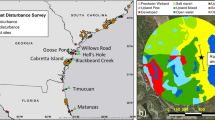Abstract
Geomorphology may be an important predictor of vegetation pattern in systems where suceptibility to disturbance is unevenly distributed across the landscape. Salt marsh communities exhibit spatial pattern in vegetation at a variety of spatial scales. In coastal Georgia, the low marsh is a virtual monoculture ofSpartina alterniflora interspersed with patches of species that are more typical of the high marsh. These localized disturbances are most likely created by wrack mats, mats of dead vegetation which can compact and smother underlying vegetation creating bare patches for colonization by high marsh species. We investigated the spatial pattern of disturbed patches along a 2 km section of Dean Creek, a tidal creek at the southwestern end of Sapelo Island, Georgia, U.S. We used a discriminant model to explore the relationship between tidal creek morphology (e.g., the presence of drainage channels and creek bends) and the spatial distribution of disturbed patches. The model predicted vegetation pattern along the creek with relatively high accuracy (>70%). Areas where water movement is slowed or multidirectional (e.g., along creek bends and near drainage channels) were most susceptible to disturbance. Our findings suggest an important functional linkage between geomorphology and vegetation pattern in salt marsh communities.
Similar content being viewed by others
Literature Cited
Bertness, M. D. andA. M. Ellison. 1987. Determinations of pattern in a New England salt marsh plant community.Ecological Monographs 57:129–147.
Bertness, M. D., L. Gough, andS. W. Shumway. 1992. Salt tolerances and the distribution of fugitive plant species.Ecology 73:1842–1851.
Crowley, P. H. 1992. Resampling methods for computation-intensive data analysis in ecology and evolution.Annual Review of Ecology and Systematics 23:405–447.
Efron, B. andR. J. Tibshirani 1993. An Introduction to the Bootstrap. Chapman and Hall, New York.
Hartman, J. M. 1988. Recolonization of small disturbance patches in a New England salt marsh.American Journal of Botany 75:1625–1631.
Hartman, J., H. Caswell, and I. Valiela. 1984. Effects of wrack accumulation on salt marsh vegetation, p. 99–102.In J. Boutler (ed.), Proceedings of the 17th European Marine Biology Symposium. Oceanologica Acta Special Issue, Brest, France.
Hopkins, D. R. andV. T. Parker. 1984. A study of the seed bank of a salt marsh in northern San Francisco Bay.American Journal of Botany 71:348–355.
Leopold, L. B., M. G. Wolman, andJ. P. Miller. 1964. Fluvial Processes in Geomorphology. W. H. G. Freeman, San Francisco, California.
Pennings, S. C. andC. L. Richards. 1998. Effects of wrack burial in salt-stressed habitats:Batis maritima in a southwest Atlantic salt marsh.Ecography 21:630–638.
Pickett, S. T. A., J. Kolasa, J. J. Armesto, andS. L. Collins. 1989. The ecological concept of disturbance and its expression at various hierarchical levels.Oikos 54:129–136.
Pickett, S. T. A. andP. S. White. 1985. The Ecology of Natural Disturbance and Patch Dynamics. Academic Press, Inc., Orlando, Florida.
Reidenbaugh, T. G. andW. C. Banta. 1980. Origin and effects ofSpartina wrack in a Virginia salt marsh.Gulf Research Reports 6:393–401.
Risser, P. G., J. R. Karr, andR. T. T. Forman. 1984. Landscape ecology: Directions and approaches.Illinois Natural History Survey Special Publication 2:1–18.
Romme, W. H. 1982. Fire and landscape diversity in subalpine forests of Yelowstone National Park.Ecological Monographs 52: 199–221.
SAS Institute, Inc. 1994. Release 6.10 edition. SAS Institute, Cary, North Carolina.
Sprugel, D. G. andF. H. Bormann. 1981. Natural disturbance and the steady state on high-altitude balsam fir forest.Science 211:390–393.
Valiela, I. andC. S. Rietsma. 1995. Disturbance of salt marsh vegetation by wrack mats in Great Sippewissett Marsh.Oecologia 102:106–112.
Wiegert, R. G. and B. J. Freeman. 1990. Tidal Salt Marshes of the Southeastern Atlantic Coast: A Community Profile. U.S. Fish and Wildlife Biological Report 85, Washington, D.C.
Author information
Authors and Affiliations
Rights and permissions
About this article
Cite this article
Fischer, J.M., Reed-Andersen, T., Klug, J.L. et al. Spatial pattern of localized disturbance along a Southeastern salt marsh tidal creek. Estuaries 23, 565–571 (2000). https://doi.org/10.2307/1353146
Received:
Accepted:
Issue Date:
DOI: https://doi.org/10.2307/1353146




